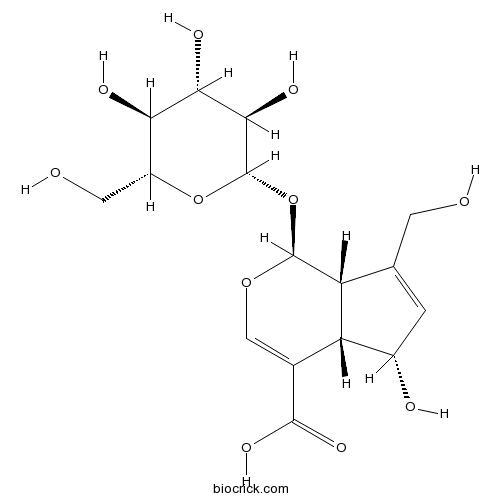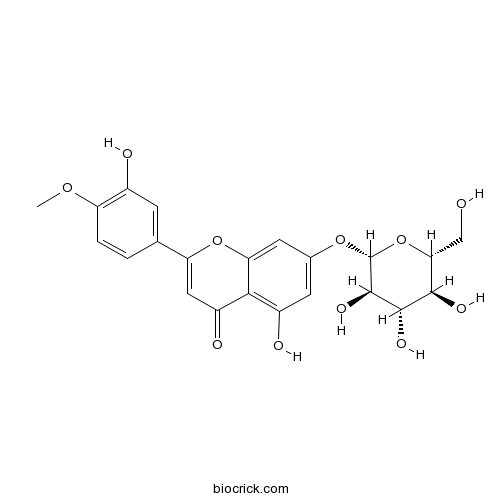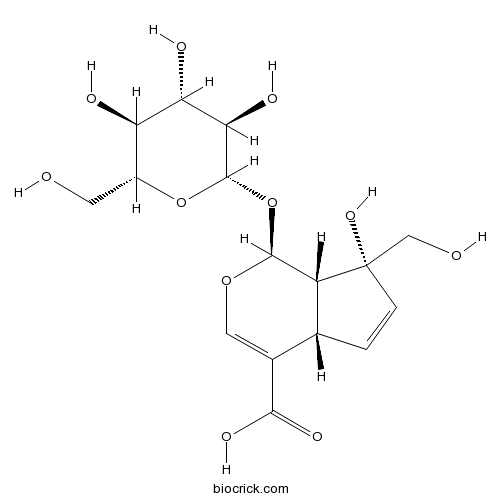Galium verum
Galium verum
1. The products in our compound library are selected from thousands of unique natural products; 2. It has the characteristics of diverse structure, diverse sources and wide coverage of activities; 3. Provide information on the activity of products from major journals, patents and research reports around the world, providing theoretical direction and research basis for further research and screening; 4. Free combination according to the type, source, target and disease of natural product; 5. The compound powder is placed in a covered tube and then discharged into a 10 x 10 cryostat; 6. Transport in ice pack or dry ice pack. Please store it at -20 °C as soon as possible after receiving the product, and use it as soon as possible after opening.
Natural products/compounds from Galium verum
- Cat.No. Product Name CAS Number COA
-
BCN3323
Deacetylasperulosidic acid14259-55-3
Instructions

-
BCN5328
Diosmetin-7-O-beta-D-glucopyranoside20126-59-4
Instructions

-
BCN4993
Diosimin520-27-4
Instructions

-
BCN2356
Diosmetin520-34-3
Instructions

-
BCN6280
Monotropein5945-50-6
Instructions

Chemo-mapping and biochemical-modulatory and antioxidant/prooxidant effect of Galium verum extract during acute restraint and dark stress in female rats.[Pubmed: 29969484]
Galium verum is a well-known medicinal plant which is used in various pathologies. G. verum extracts are characterized here using chromatography, where among the rich pool of phenolic acids of flavonoids two known anti-stress modulators, chlorogenic acid and rutin are identified in high quantities. Additionally, the extracts are characterized using a series of in vitro assays (EPR, DPPH, TPC and TEAC). Considering the chemical findings, the potential beneficial effects of the G. verum extract are explored here in a living organism exposed to stress induced oxidative damages. Thus, the biochemical-modulatory and antioxidant roles of two doses of G. verum extract are examined in animals exposed to acute restraint and dark stress (S). The animals were divided in groups [control, S, SG1 (exposed to 25 mg G. verum extract), SG2 (50 mg extract)]. Increased levels of lipid peroxidation (TBARS from 4.43 to 8.06 nmol/mL), corticosterone from 0.43 to 1.96 μg/dL and epinephrine from 44.43 to 126.7 μg/mL, as well as decreased antioxidant enzymes activities (SOD/CAT) were observed in the S group. The G. verum extract afforded a near-normal equilibrium within the biochemical parameters of animals exposed to RS, by reducing oxidative damage (TBARS at a 3.73 nmol/mL; CS at 0.90 μg/dL; EP at 63.72 μg/mL) and by restoring the antioxidant balance.
Expression, activation and processing of a novel plant milk-clotting aspartic protease in Pichia pastoris.[Pubmed: 29339117]
Galium verum, also known as Lady's Bedstraw or Cheese Rennet, is an herbaceous perennial plant traditionally used in cheese-making. We used RACE PCR to isolate novel enzymes from Galium verum with the ability to clot milk. This approach generated two cDNA sequences (named preprogaline A and B) encoding proteins displaying the typical plant aspartic protease primary structure. Preprogaline B was expressed in the yeast Pichia pastoris, after deleting and replacing its original signal peptide with the yeast α-factor signal peptide from Saccharomyces cerevisiae. The secreted recombinant protein was obtained by growing P. pastoris in YPD medium and had the ability to clot milk. The mature form of progaline B is a heterodimeric glycosylated enzyme, with a molecular weight of approximately 48 kDa, that contains a heavy (30.7 kDa) and a light (13.5 kDa) polypeptide chains linked by disulfide bonds. Western blot analysis revealed that progaline B is activated by the acidification of the yeast culture medium and that enzymatic activation requires two steps. First the precursor protein is cleaved into two polypeptide chains by partial removal of the plant-specific insert (PSI) present in plant aspartic proteases; this is later followed by propeptide removal. By altering the pH of the P. pastoris culture medium, we were able to obtain either active or inactive forms of the enzyme. Recombinant progaline B displayed a κ-casein hydrolysis pattern analogous to those produced by the animal and microbial coagulants currently used in the dairy industry, but it exhibited a different digestion profile on α- and β-caseins. The plant protease progaline B displays milk-clotting activities suitable for the production of novel dairy products.
The effect of Diosmin on the blood proteome in a rat model of venous thrombosis.[Pubmed: 28606843]
Diosmin is the aglycone moiety of diosmetin (3',5,7 trihydroxy-4'methoxy radicals flavonoids), a naturally occurring flavone glycoside, whose antithrombotic effect was studied in rats. This study was designed to find the protein changes of venous thrombosis in Wistar rats comparing conditions with and without Diosmin treatment by two-dimensional gel electrophoresis (2-DE), and investigate the effect of a crucial protein known as CEP350 on human vascular endothelial cell growth. Through prior chromatographic purification with macroporous absorption resin (AB-8) and polyamide, Diosmin was isolated from Galium verum L. by solvent extraction, then purified to 98% purity using HPLC. Wistar rats were divided into control group, model group, and prevention group. And their venous thrombosis tissue segments were dissected and prepared for histopathological examination and detection of plasma protein C (PC). Next, proteomic analysis was performed with the samples. Low-abundance proteins of the three groups were separated by two-dimensional gel electrophoresis (2-DE). 2-DE analysis revealed that 191 protein spots were differentially expressed among those three groups. For protein identification, we selected six spots to use matrix assisted laser desorption/ionization-time of flight-mass spectrometry (MALDI-TOF-MS) detection, and then do the homology search in NCBI database. Considering characteristics of these proteins, we proposed CEP350 is related to spindle assembly. Furthermore, we used Lipofectamine 2000 to transfect HUVECs with CEP350 siRNA and evaluated the extent of silencing using real time-polymerase chain reaction (RT-PCR). Cells were stained for immunofluorescence with tubulin-tracker red, and structural changes were analyzed using laser scanning confocal microscope. We concluded that CEP350 depletion decreased microtubule stability. Dosmin could modulate the assemble of spindle from unevenly distributing and protect body from varicose veins by regulating CEP350.
The Anthelmintic Ingredient Moxidectin Negatively Affects Seed Germination of Three Temperate Grassland Species.[Pubmed: 27846249]
In animal farming, anthelmintics are regularly applied to control gastrointestinal nematodes. There is plenty of evidence that also non-target organisms, such as dung beetles, are negatively affected by residues of anthelmintics in faeces of domestic ungulates. By contrast, knowledge about possible effects on wild plants is scarce. To bridge this gap of knowledge, we tested for effects of the common anthelmintic formulation Cydectin and its active ingredient moxidectin on seed germination. We conducted a feeding experiment with sheep and germination experiments in a climate chamber. Three wide-spread plant species of temperate grasslands (Centaurea jacea, Galium verum, Plantago lanceolata) were studied. We found significant influences of both, Cydectin and moxidectin, on germination of the tested species. Across species, both formulation and active ingredient solely led to a decrease in germination percentage and synchrony of germination and an increase in mean germination time with the formulation showing a more pronounced response pattern. Our study shows for the first time that anthelmintics have the potential to negatively affect plant regeneration. This has practical implications for nature conservation since our results suggest that treatments of livestock with anthelmintics should be carefully timed to not impede endozoochorous seed exchange between plant populations.
[Effects and related mechanism of flavone from Galium verum L on peroxide induced oxidative injury in human umbilical vein endothelial cells].[Pubmed: 27530947]
To investigate the effects of flavone from Galium verum L (FGVL) on hydrogen peroxide induced oxidative injury in human umbilical vein endothelial cells (HUVEC), and explore related mechanisms.
Antihaemolytic activity of thirty herbal extracts in mouse red blood cells.[Pubmed: 25720027]
Reactive oxygen species (ROS) can lead to haemolysis and eventually to diseases such as thalassemia and sickle cell anaemia. Their action can be counteracted by the antihaemolytic activity of therapeutic agents. The aim of our study was to identify plants that most efficiently counteract ROS-caused haemolysis. From ten plants known for their antioxidant activity (Orobanche orientalis G. Beck, Cucumis melo L., Albizzia julibrissin Durazz, Galium verum L., Scutellaria tournefortii Benth, Crocus caspius Fischer & Meyer, Sambucus ebulus L., Danae racemosa L., Rubus fruticsos L., and Artemisia absinthium L.) we prepared 30 extracts using three extraction methods (percolation, Soxhlet, and ultrasound-assisted extraction) to see whether the extraction method affects antihaemolytic efficiency, and one extraction method (polyphenol extraction) to see how much of this action is phenol-related. Extract antihaemolytic activity was determined in mice red blood cells and compared to that of vitamin C as a known antioxidant. Nine of our extracts were more potent than vitamin C, of which G. verum (aerial parts/percolation) and S. tournefortii (aerial parts/polyphenol) extracts were the most potent, with an IC50 of 1.32 and 2.08 μg mL⁻¹, respectively. Haemolysis inhibition depended on extract concentration and the method of extraction. These plants could provide accessible sources of natural antioxidants to the pharmaceutical industry.
Analysis of Phenolic Compounds in Some Medicinal Herbs by LC-MS.[Pubmed: 25583972]
In this paper, a liquid chromatography-atmospheric pressure chemical ionization-mass spectrometry in negative mode method was developed for the identification and quantitative determination of 13 individual phenolics (chlorogenic acid, caffeic acid, coumaric acid, ferulic acid, (+)-catechin, (-)-epicatechin, rutin, quercitrin, isoquercitrin, fisetin, isorhamnetin, hesperidin and chrysin) from ethanolic extracts [30, 50 and 70% (w/v)] of Calendula officinalis, Hypericum perforatum, Galium verum and Origanum vulgare and some commercial extracts of these medicinal herbs. Correlation coefficients (r(2)) from calibration curves for all the compounds were between 0.9971 and 0.9996. Limit of detection was in the range of 0.070-0.280 µg/mL and limit of quantification was from 0.233 to 0.932 µg/mL. The method was partially validated and the results obtained are: the intra- and interday relative standard deviation values were within 0.086 and 2.821% and recovery values vary from 95.84% (coumaric acid) to 103.20% (rutin).
Galium verum aqueous extract strongly inhibits the motility of head and neck cancer cell lines and protects mucosal keratinocytes against toxic DNA damage.[Pubmed: 25017936]
Galium verum, also known as Lady's Bedstraw, is an herbaceous plant native to Europe and Asia, and has been used in traditional medicine as an anticancer medicine applied in most cases as a decoction. The influence of a Galium verum decoction on the head and neck cancer cell lines HLaC78 and FADU was analyzed and proved to be toxic in high doses on both cell lines. Cytotoxicity appeared to be influenced by expression of p-glycoprotein (MDR-1) in the carcinoma cell lines. Mucosal keratinocytes, although void of MDR-1 expression, showed only low sensitivity against high Galium concentrations. Sublethal doses of Galium extract acted as strong inhibitors of motility, as shown by a spheroid-based invasion analysis on Matrigel-coated surfaces. Inhibition of invasion was significantly more pronounced in the invasive HLaC78 cell line. mRNA expression analysis of matrix metalloproteinases MMP-2 and MMP-9 and their inhibitors TIMP-1/-2 revealed significant TIMP-1 upregulation after an 8-h Galium exposition in FADU cells. Gelatinolytic activity, however, was not influenced by Galium extract in HLaC78, in the FADU cells MMP-2/-9 activity was slightly increased after incubation with Galium extract. In primary mucosal keratinocytes, Galium decoction protected DNA against benz[a]pyrene, one of the most DNA toxic agents in cigarette smoke. In conclusion Galium extract may be useful as a preventive and/or a concomitant therapeutic approach in head and neck cancer.
Effect of Galium verum aqueous extract on growth, motility and gene expression in drug-sensitive and -resistant laryngeal carcinoma cell lines.[Pubmed: 24366449]
Galium verum, also known as Lady's Bedstraw, is a herbaceous perennial plant of the family Rubiaceae, native to Europe and Asia and used in traditional medicine as an anticancer medicine. It is used as a decoction in most traditional recipes, applied externally as well as internally. We produced a Galium verum decoction and applied it in vitro to chemosensitive (Hep-2 and HLaC79) and chemoresistant, P-glycoprotein-overexpressing (Hep2-Tax, HLaC79-Tax) laryngeal carcinoma cell lines. It could be demonstrated that Galium aqueous extract is cytotoxic for all cell lines. A detailed spheroid-based 3D invasion analysis of Hep2 and Hep2-Tax in semisolid collagen gels and on different extracellular matrix coatings was performed, which showed an inhibition of invasion by sublethal concentrations of Galium decoction and proved to be even more pronounced in the more aggressively invading chemoresistant Hep2-Tax cell line. Gelatinolytic activity of MMP-2 was downregulated in three of the four cell lines. Angiogenesis (endothelial tube formation) in contrast, was not affected by Galium aqueous extract. Gene expression array on HLaC79 and Hep2 cell lines treated with Galium decoction vs. untreated controls revealed no unique pathway activation patterns in these cells. Results are discussed with respect to the use of herbal drugs as a preventive and/or a concomitant therapeutic approach in head and neck cancer.


